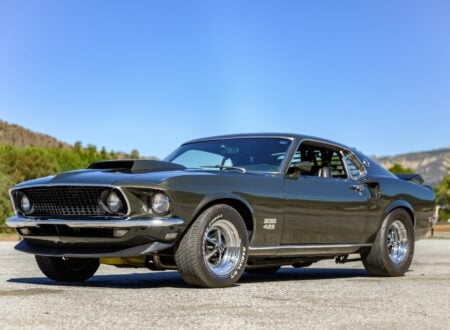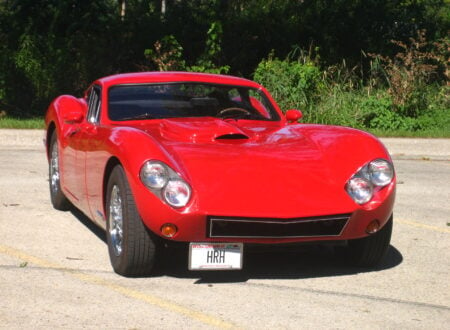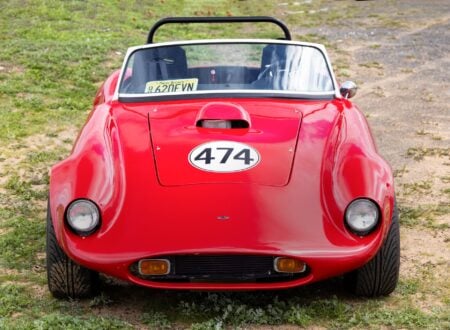The Chevrolet Suburban – Practical Becomes Popular
In thinking about the Chevrolet Suburban it might be best to start with the things we aspire to when we are young, and how that changes when we are old.
You’ve possibly heard of a song from the 1960’s called “When I was Young” by The Animals in which they sing about the newness and vividness of being young and the experiences of life. Remembering back to when I was young it was a time when the new and different things were fascinating and when it comes to motor cars the aspiration was to own something expensive and exotic. A young John Lennon of the Beatles bought a Ferrari just after he got his driver’s license for example.
If I’d had that much money burning a hole in my wallet I would have bought a Bizzarini GT Strada. Happily or unhappily I didn’t have vast quantities of disposable cash so I finished up with a Datsun 1600 painted bright psychedelic orange.
As we grow older and start to sort out in our minds what is actually important and what isn’t then the taste in automobiles goes through a metamorphosis and the practical and reliable becomes far more attractive until you get to the point where you prefer a sensible station wagon with room for a family and enough ground clearance to avoid damage by potholes and road kill encountered on country trips. As an example, while I was living in China I met a guy who’d had what is likely the most expensive car crash in the country.
He and his friends had hired an expressway so they could drive their Ferraris the way Ferraris are made to be driven. Unfortunately while he was hammering up the expressway with the tachometer indicating that both engine and car were going very quickly indeed he encountered a severe dip in the road, a dip so severe that it collapsed the front suspension with exceedingly untidy and expensive results. If you’re on rough roads you probably don’t want to be driving a Ferrari or anything similar, you want ground clearance and durable suspension and tires.

Perhaps this is why over in Australia General Motors Holden have just announced that they won’t be making the Holden Commodore sedan anymore. It would seem the car buying public have moved on from the “When I was Young” V8 Supercars and now just want practical SUV’s: and of course the Chevrolet Suburban was one of the first of the “SUV’s”, so far in front of the pack it was invented before the term “SUV” was invented.
The Chevrolet Suburban Pioneers (1934-1946)
The story of the Chevrolet Suburban began in 1933 in an America that was emerging from the rigors of the Wall Street Crash and the Great Depression. It was released to a car buying public, many of whom had experienced the battlefields of the First World War, and the joint experiences of the War and the Depression had shaped people’s thinking about what was important in life and what wasn’t.
They had lived through experiences that taught them to sacrifice, to live within their means, and to enjoy life’s precious simple pleasures, family, and trusted friends, and perhaps a fishing or hunting trip or two.
It was into this world of mostly practical people that the Chevrolet Suburban made its debut.

The motivation for the building of that first Chevrolet Suburban was that it had to be tough, it had to be able to be driven on the roughest of roads and not suffer damage. It had to be big enough to carry a decent load of people or goods or both. With the tough and big concept firmly in mind Chevrolet’s engineers decided to base this new vehicle on a truck chassis and put an all steel station wagon body on it.
Prior to this in 1933 Chevrolet had trialed an eight seater wood body on a half ton light truck chassis in vehicles made for the Civilian Conservation Corps and National Guard. The wood bodywork was found wanting being too fragile for the purposes intended and so it was decided to make the bodywork of the same stuff used to build battleships – steel.

It was in 1934 that Chevrolet debuted their cross between a half ton light truck, a passenger and cargo car, and a battleship: they called it the Chevrolet Suburban Carryall. This up to eight seater vehicle was based on the same chassis and mechanicals as its wood bodied predecessor but the bodywork was made of the tough decent gauge steel that American cars of the 1930’s were made of: steel that was not quite bulletproof, as Bonnie and Clyde found out, but steel that was sufficiently bullet resistant that American police asked for revolvers with better penetrating power.
A request which led to the creation of the Smith & Wesson “Heavy Duty” chambered for the 38/44 which was a more heavily loaded 38 Special chambered in a strongly constructed N Frame revolver. That development would lead to the creation of the famous and popular .357 Magnum revolver cartridge in 1935.
The seating arrangement was for three passengers on the front bench seat, two in the intermediate rear seat, and three on the rear bench seat. Rear doors were either hinged side opening or optionally a folding tailgate with lifting rear window. Rear seats were made to be removable to enable the vehicle to be adapted to load carrying when required.
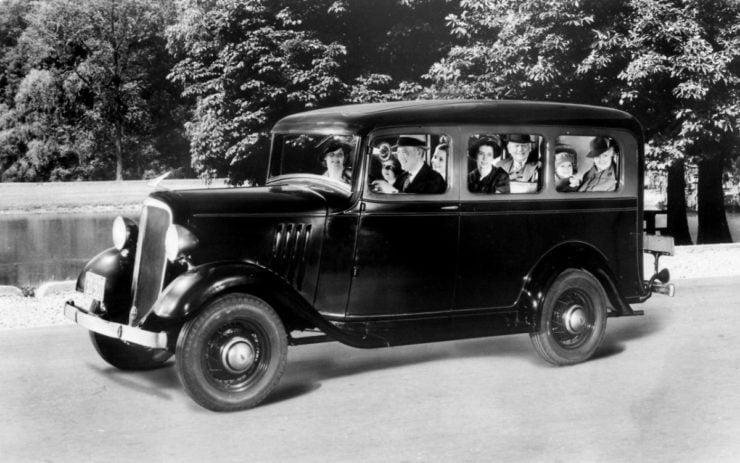
The power unit used for this first Chevrolet Suburban Carryall was their “Stovebolt” 194 cu. in. OHV inline six cylinder gasoline/petrol engine producing 60 hp. This engine had first appeared in 1929 and had earned the nickname “Stovebolt” because the bolts used on it looked like the ones that held wood stoves together. This engine had three main bearings which were kept oiled by pressurized lubrication while the con-rod bearings were splash lubricated. The compression ratio was 5.2:1. The transmission was a three speed manual gearbox.
In 1941 Chevrolet updated that First Generation Suburban Carryall with a new Second Generation version with a 1940’s styled body while the engine was the enlarged Second Generation of the “stovebolt” inline six with a capacity of 216 cu. in. (3.5 liters) with a 6.6:1 compression ratio and producing 90 hp. This four main bearing engine retained a partial oil pressure lubrication system with the big end bearings being fitted with oil scoops to pick up oil from an oil trough incorporated into the oil pan. The transmission remained a three speed manual.
This model remained in production up until 1946 so these were the Chevrolet Suburban Carryall models that were supplied to the US military for service during the Second World War. In fact the vast majority of production of this model went to the US military for the war effort, shifting into civilian hands after the war when the ex military vehicles were sold off as surplus.
The Advance Design Chevrolet Suburban (1947-1954)
For 1947 Chevrolet based the Suburban on their new “Advance Design” series of light trucks which included half ton, three quarter ton and one ton versions, the Suburban being based on the half ton model.

The styling of this Third Generation Chevrolet Suburban was notably different and it looked much more like a station wagon based on a light truck by comparison with its predecessors which had managed to look like hardened up station wagons.
The seating arrangements remained very similar to the earlier Suburbans but not identical. The front bench seat was divided in this new model with a two seat bench at the driver’s side with a single seat on the passenger’s side. The passenger’s side seat was made to fold forward so that passengers could get to the rear seats. The middle was a two seat bench leaving room for passengers to move beside it to get to the full width three seat bench in the rear.

The engine used for this version of the Suburban was still the four main bearing “Stovebolt” inline six cylinder of 216 cu. in. (3.5 liters) with a 6.6:1 compression ratio producing 90 hp. During 1954 the “stovebolt” engine was phased out and replaced by the 235 cu. in. (3.9 liter) “Thriftmaster” inline six which produced around 90 hp.
The Thriftmaster engine was typically mated to a three or four speed manual transmission, or a Hydra-Matic four speed automatic. This “Thriftmaster” engine was the same basic power plant that was updated to become the “Blue Flame” engine of the first Chevrolet Corvette.
The Fourth and Fifth Generation Suburban (1955-1966)
The fourth generation of the Chevrolet Suburban was introduced on March 25, 1955 and its styling was markedly different: this was the 1950’s and American passenger cars were moving to the avant-garde styling with fins, lots of chrome, wrap-around windscreens, and a dashboard reminiscent of a Wurlitzer juke box. The choices for the rear doors remained the side-hinged swing doors or tailgate with lift-up rear window.

To go with the new look there were some changes under the hood which included a small block V8 265 cu. in. (4.3 liter) engine producing 145 hp in addition to the inline six cylinder Thriftmaster. Transmission options remained the three speed or four speed manual or four speed Hydra-Matic automatic.
The major first for the Suburban came in 1957 when it was first offered with four-wheel-drive. This expanded the customer base for the Suburban and made it an excellent choice for agricultural and industrial users as well as being a practically perfect hunting, shooting and fishing recreational vehicle – the sort of vehicle that would ultimately inspire someone to invent the descriptive name “Sports Utility Vehicle”.

In 1960 the Fifth Generation was introduced and for the first time provided a fully independent front suspension just like a Chevrolet passenger car. This improved passenger comfort and overall vehicle handling, especially on the rough roads that the Suburban was created to handle with aplomb.
The styling included a near flat hood/bonnet with flattened oval ports at the front above the grille, a styling feature that would only last for a couple of years before being removed in the 1962 styling face-lift. Wrap-around windscreens were all the rage on passenger cars so the Suburban acquired one of those also. The rear door options remained the same with side-opening doors or tailgate with lift up rear window.

In addition to the styling changes there were significant mechanical changes. The Fifth Generation Suburban can be found fitted with any of four inline six cylinder gasoline/petrol engines, a V6, or one of two V8’s. The most significant was perhaps the V6 which was one of the first V6 engines produced by a US manufacturer. This engine was of 305 cu. in. (5.0 liter) capacity and in its first iteration produced 150 hp @ 3,600 rpm with 260 lb/ft of torque @ 1,600 rpm. In later versions of this engine the power would increase to 165 hp @ 3,600 rpm with 280 lb/ft of torque at 1,600 rpm.
The inline six cylinder engines were the 235 cu. in. (3.9 liter) used between 1960-1962; the 230 cu. in. (3.8 liter) between 1963-1965; the 292 cu. in. (4.8 liter) from 1963-1966; and the 250 cu. in. (4.1 liter) in 1966.
The V8 engines were the 283 cu. in. (4.6 liter) from 1960-1966, and the 327 cu. in. (5.4 liter) in 1966.
The Sixth Generation (1967-1972)
The next generation Chevrolet Suburban went from being a three door station wagon to having an additional door on the passenger side to make entry to and exit from the rear seats much easier. The body styling was refined and simplified by comparison with the fussiness of the Fourth Generation model so it looked very 1960’s modern. For the Brazilian market a five door option was provided.
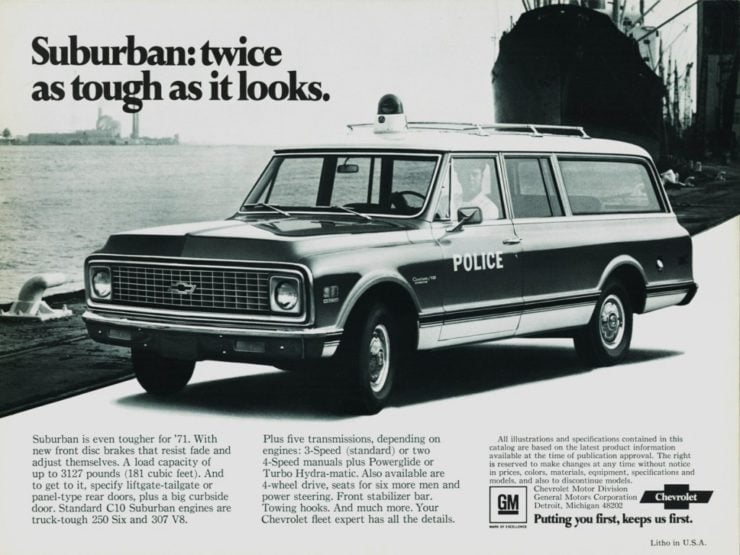
The V6 305 cu. in. engine was carried over from the previous series but in the later version producing 165 hp. The inline six cylinder engines for this model were: the 250 cu. in. (4.1 liter); the 292 cu. in. (4.8 liter); and the 283 cu. in. (4.6 liter). The small block V8 engines were: the 307 cu. in. (5.0 liter); 327 cu. in. (5.4 liter); and the 350 cu. in. (5.7 liter); The big block V8 engine was the 396 cu. in. (6.5 liter).

In 1971 this was the first Chevrolet Suburban to be offered with disc brakes on the front wheels and the following year the coil spring rear suspension ended production for the two-wheel-drive models.
The Long Lived Seventh Generation (1973-1991)
The Seventh Generation series of Chevrolet Suburbans would turn out to have the longest production run. As the old saying goes “If it ain’t broke don’t fix it”: and the Chevrolet Suburban was a refined and practical motor vehicle with about the only big downside to owning one being the fuel consumption: these were a vehicle that liked gasoline in large quantities.
To mitigate against this one of the better solutions is to fit diesel engines and that is exactly what General Motors did. There were two diesels used: the 350 cu. in. (5.7 liter) LF9 V8 which was used between 1978–81; and the 379 cu. in. (6.2 liter) Detroit Diesel V8 which was installed between 1982–91.

The gasoline engines for the Seventh Generation include the 250 cu. in. (4.1 liter) inline six and five V8’s: the 307 cu. in. (5.0 liter) and 350 cu. in. (5.7 liter) used in the previous model; a 305 cu. in. (5.0 liter) used from 1976- 1988); a 400 cu. in. (6.6 liter) used from 1976-1980; and the whopping gas guzzling 454 cu. in. (7.4 liter) for the person who needs the extra power to tow something heavy, such as their Ferrari speedboat for example.
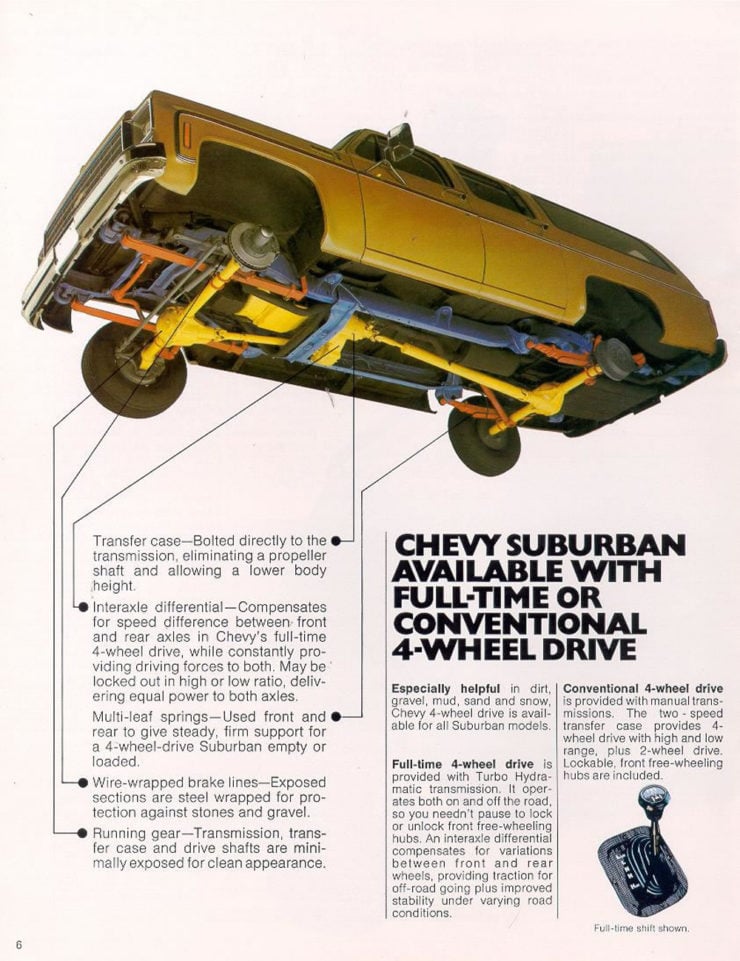
For 1987 some engines were switched from old fashioned carburetors to new fashioned fuel injection which tended to make engines more efficient and economical, although the carburetor option was provided for the 454 cu. in. V8 for a couple more years.
In order to tow your speedboat Chevrolet provided more transmission options to go with the larger and more powerful engines: these included three and four speed Turbo HydraMatic automatic transmissions. An Eaton automatic locking rear differential was also available as an option as well.

The body was treated to an additional rear door for passengers making it a five door wagon as the previous model for the Brazilian market had been.
This model survived in production for sufficiently long that it had ABS (Anti-Lock Braking System) braking fitted for the rear in 1990.
The Eighth Generation (1992-1999) and the Australian GM Holden Suburban (1998-2001)
The next generation of the Suburban continued the five door body pattern with new modernized body styling by Chuck Jordan. This model continued the 2WD and 4WD options and also featured a leaf spring rear suspension with a live axle. The front suspension differed between the 2WD and 4WD versions with the 2WD having coil springs and the 4WD being fitted with a torsion bar suspension.

For this model the diesel engines were the 395 cu. in. (6.5 liter) turbocharged V8 and the 454 cu. in. (7.4 liter) V8, which was originally the GM L19 producing 230 hp combined with torque of 380 lb/ft. In 1996 this engine was upgraded to the Vortech 7400 L29 version which was more efficient and produced 290 hp @ 4,000 rpm with 410 lb/ft of torque @ 3,200 rpm.
The gasoline engine line-up included the 5.7 liter V8 first in L05 guise and later in 1996 as a Vortech L31 for the half-ton 1500 models. Similarly the 7.4 liter V8 was first the L19 and then in 1996 the Vortech L29 was used, but only in the thee quarter ton 2500 model Suburban.
The brakes became ABS on all four wheels for both the 2WD and 4WD models and in 1995 a driver’s side airbag was introduced to be followed by a passenger side airbag in 1997.
The 4WD models were given push-button 4WD activation in 1996 with 1997 seeing the AutoTrac constant 4WD system fitted.
In 1997 Chevrolet decided to try the Suburban in the Australian and New Zealand markets to see if the Aussies and the Kiwis would embrace this big and beautiful vehicle. The Suburban made her debut at the Australian Sydney Motor Show in October of that year badged as a Holden Suburban despite the fact that it was in fact built in Mexico.
Holden was General Motors Australian subsidiary and had a long tradition of selling cars designed and built in Australia which helped the Australian buying public have a genuine sense of ownership of the brand, it was seen as “Australia’s Own Car”, and this encouraged Australians to own them. So the Holden Suburban piggybacked on that tradition regardless of its actual country of manufacture.

Australian’s drive on the left side of the road, a legacy of their British colonial heritage, and so the Holden Suburban was made right hand drive and was in production from February 1998 until January 2001. After that time any Suburbans imported into Australia or New Zealand wore the Chevrolet badge.
The engine options for the Holden Suburban were the 5.7 liter V8 petrol/gasoline engine delivering 255 hp with 330 lb/ft of torque and fuel consumption of 13 mpg using the Imperial gallon as traditionally used in Australia, 10.8 miles to the US gallon or 19.7 liters per 100 km; or the 6.5 liter Turbo diesel V8 which produced 194 hp and 430 lb/ft of torque making it a great engine for towing. Fuel consumption was 14 mpg (Imperial), 11.9 mpg US, or 19.7 liters per 100 km.
These fuel consumption figures put the Suburban in approximately the same league as the Land Rover, Toyota Land Cruiser, and Nissan Patrol making it competitive with those common 4WD vehicles. As an example the Land Rover Series III long wheelbase Safari station wagon I owned was fitted with a Holden inline six cylinder 202 cu. in. “Red” motor and the vehicle typically did 14 miles to the Imperial gallon.
Diesel fuel tended to be favored by primary producers and miners, and by many other Australians on the land. Diesel engines consume a tad less fuel than their gasoline cousins also which helped make them popular in the Outback.

For the Australian market the right hand drive dashboard was a modified version of that used in the Chevrolet Blazer and the Holden Suburban was made in a base level, LS and LT models. In the LT luxury model the front bench seat was replaced with electric twin bucket seats, thus gaining more comfort for the front seat passengers but reducing seating capacity from nine to eight.
The Ninth Generation (2000-2006)
Based on the GMT800 platform series the Ninth Generation Chevrolet Suburban was built on the GMT830 platform. It was made in half-ton 1500 and three-quarter ton 2500 versions and was a major step away from the legacy technology of its predecessors although the push button selector for 2WD/4WD high and low range remained.
The engines were new: the standard gasoline engine was the 325 cu. in. (5.3 liter) Vortec 5300 V8 for the 1500 and the Vortech 6000 364 cu. in. (6.0 liter) V8 for the 2500. The 5300 had a cast iron block and aluminum heads. The earliest version of the Vortech 6000 produced between 1999 and 2000 was fitted with cast iron cylinder heads but for Chevrolet Suburban the engines of the later versions were fitted with cast iron block and aluminum cylinder heads.
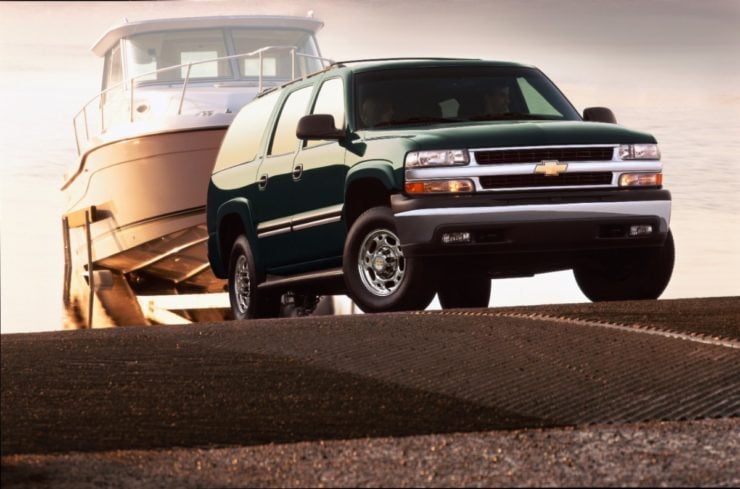
The first Vortec 5300 engines made from 2000-2003 produced 285 hp with 325 lb/ft of torque. The next version from 2002-2003 had a power output of 285 hp and 320 lb/ft of torque, while the 2004-2007 engine upped the power to 295 hp combined with and 335 lb/ft of torque.
The Vortec 6000 engines had a capacity of 5,967 cc and produced 300 hp to 325 hp and torque of 360 lb/ft to 370 lb/ft depending on version.
Also available as an optional extra for the 2500 was the Vortec 8100 large block V8 gasoline/petrol engine. This engine had cast iron block and cylinder heads and had a capacity of 496 cu. in. Power was 325 hp at 4,200 rpm with 447 lb/ft of torque at 3,200 rpm.
These vehicles were truly 21st Century Chevrolet Suburbans with four wheel disc brakes and ABS, more sophisticated suspension that included the option for rear self leveling on the LS model and “Autoride” self-leveling load compensating on the luxury LT models.
Apart from climate control and the Stabilitrak electronic stability system an intriguing option for the 2500 Suburban was the Quadrasteer four wheel steering system. This initially started out as a very expensive optional extra adding USD$7,000.00 to the price but in order to popularize it GM progressively dropped the price until it was an attractively cheap USD$1,000.00 to appeal to the most miserly Ebenezer Scrooge like buyers.
The Quadrasteer system was popular for customers who were towing a boat or caravan as it made reversing much easier.
The Tenth Generation (2007-2014)
For 2007 and for the next seven years the Chevrolet Suburban was based on the GMT900 platform, specifically the GMT931. The Vortec 5300 and 6000 engines continued in use in the Suburban 1500 and 2500 respectively as had been the case with the Ninth Generation vehicles and this model featured disc brakes on all wheels. The suspension was equipped with load leveling and in 2003 the Stabilitrack vehicle stability system as standard. Also for occupant safety the airbag system was upgraded to dual level.
Along with the styling changes this model saw the incorporation of various technology features such as Bluetooth and USB connections typically used so occupants could plug in their music device and play whatever they fancied over the sound system: so you could have music wherever you go.
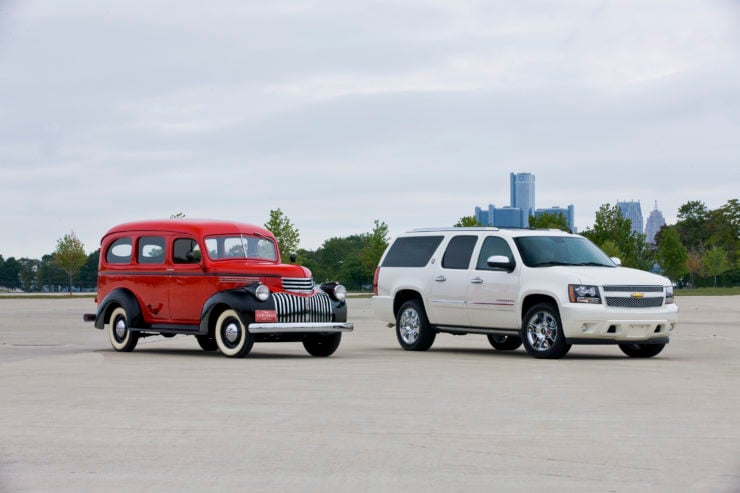
The interior fittings were made more and more luxurious with different trim options and tri-zone climate control for front, middle and rear passengers.
The body styling for this model was done in a wind tunnel to improve its ability to slip through the air and thus improve fuel consumption, especially on long distance country trips at highway speeds where this can make a significant difference in fuel consumption and thus in vehicle range.
The big event during the life of this model was the 75th Anniversary of the first Chevrolet Suburban in 2010: and so a special Anniversary model was made which was called the 75th Anniversary Diamond Edition Suburban. Production of this model was limited to 2,750 vehicles with General Motors claiming that they could only get enough of the “White Diamond” triple coat paint unique to this model for that number of vehicles.

The interior of the 75th Anniversary Diamond Edition Suburban was done in “Cashmere” leather with heated/cooled seats, and the vehicle had an array of special features including remote starting, 20″ chrome wheels, XM satellite radio, integrated navigation radio, rear-view camera and rear park assist, and Bluetooth phone support.

2012 saw trailer sway control and hill start assist added as standard features rather than as options: and then in 2014 the rear vision camera and reverse parking assist became standard fittings along with the remote vehicle starter system. By this stage of production even the base model Suburban was a very sophisticated vehicle.
The Eleventh Generation 2015-2020
The Eleventh Generation Chevrolet Suburban entered the Internet Age with great enthusiasm with customers being able to order their custom configured vehicle on-line. This new model was designed by Chip Thole and his team and it was based on the GMT K2XX platform. This means it continued to be a body on chassis frame vehicle in true truck tradition, something that made it perfect for customization.

Some of the most notable custom versions of the Suburban were the vehicles custom built for the US Secret Service who’s job it is to protect the President of the United States. These armored specially equipped vehicles included the “Roadrunner” communications vehicle, the “Halfback” protection staff vehicle, the counter assault team vehicle “Hawkeye Renegade” and the electronic countermeasures vehicle “Watchtower” among others.

The Suburban continued to be made in two main configurations: the half-ton 1500 and the three-quarter ton 2500 in either 2WD “C” or 4WD “K” variants.
The engine for the Suburban was the 325 cu. in. (5.3 liter) EcoTec3 V8 with direct fuel injection delivering 355 hp @ 5,600 rpm combined with torque of 383 lb/ft @ 4,100 rpm. With the combined benefits of the improved aerodynamic body and more efficient engine the 2WD Suburban was capable of fuel economy of around 16 mpg (US) in the city and 23 mpg US for country highway driving. The 4WD model was able to give 15 mpg US around town and 22 mpg US for Highway driving.

Among the features added to this generation was a “Lane Departure Warning” and a “Forward Collision Alert”. While the luxury LTZ model added such things as “Front Parking Assist”, and the new style passive entry and push button start which some people like.
Conclusion
The “Chevrolet Suburban” name has been in continuous use from 1934 up to the present day. The vehicle itself has gone through eleven generations each one significantly different from its predecessor but each one representing the vehicle technology of its era. Back in 1934 if you had talked about a “USB” people would have thought you were discussing American honey production: and if you’d mentioned “Bluetooth” they would have assumed you needed to visit the dentist.
Comparing the early versions of the Chevrolet Suburban with the more modern ones gives a very clear picture of the technological changes and there are of course the “Luddites” such as this writer who have a penchant for the old and much less complex classics of the past era. The vehicles that we knew how to fix with the tools commonly found in an amateur mechanic’s garage.

The Chevrolet Suburban was made to be totally practical and “no-nonsense”. It was built simple and ruggedly tough, a trustworthy tool for getting to pretty much anywhere you could think of and home safely again. The current model is probably more reliable and economical, but repairing one tends to be best undertaken by the local workshop whose staff have the specialized tools and computer equipment to manage them.
The Suburban has never been particularly famous or desirable for its fashion statement “coolness”. It has always been a practical vehicle for practical people: and I think that’s why it has survived for 85 years and counting.
Picture Credits: Chevrolet



